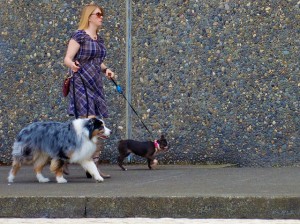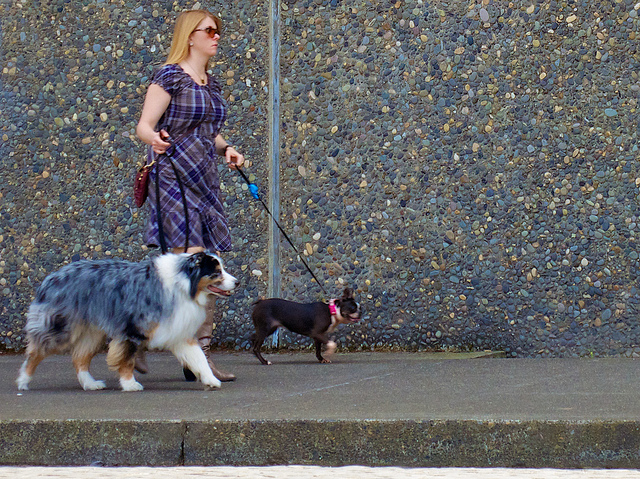Does your puppy constantly pull when you take them out on a leash? Or are they calm with the whole process of leashing or harnessing up and going outside?

Here are some tips on walking the dog and how to keep them safe:
What’s the best type of leash? “Use whatever you feel most comfortable holding,” recommends the ASPCA Animal Behavior Center’s Kristen Collins, CPDT.
- Flexi-leads are best reserved for walks in the park, when it’s safe for a dog to explore a bit further away from her pet parent. They are NOT a good idea if you’re walking in an area with high foot traffic or off-leash dogs, as the long line may get wrapped around your dog, a person’s leg or another dog.
- Many people think chain leashes look nice, but they are much heavier than nylon or leather, and they can be very hard on the hands. Even so, they sometimes work well for dogs who like to tug or bite the leash. “Metal doesn’t feel nearly as nice in a dog’s mouth,” explains Collins.
- Leather leashes are a good option because they are easiest on the hands.
- Nylon leashes can cut into hands or give a pet parent “leash burn” if a dog pulls a lot or unexpectedly lunges forward. But they come in many stylish colors and designs, and they hold up well after repeated exposure to rain and snow.
Stay Off the Grass (and Out of the Flower Beds!)Our experts at the ASPCA Poison Control Center want you to keep your walks toxin-free:
- During the warmer months, it’s important to keep your pet safe from toxic lawn and garden products. Insecticides and certain types of mulch can cause problems for our furry friends—during neighborhood strolls, please be sure to keep your pooch off the lawns of others.
- Even though popular spring bulb plants like tulips and daffodils add much to our landscape, they can cause significant stomach problems for our furry friends. If your pooch likes to stop and smell—or nibble—the flowers, please keep him on a short leash during your walks.
So Nice to Meet You!
It’s great that your friendly pooch loves meeting people during walks—but not so great that she jumps up on them. “The basic idea is to teach your dog how to sit on cue and then require her to sit to interact with people,” says Collins. “No sitting, no greeting. But if she sits, she gets to enjoy the reward of greeting her friends.” It doesn’t hurt to reward the dog with a treat—or ask the person whom she’s greeting to offer a treat.
Three Things To Bring
- If you’re planning an extended walk, be sure to bring water for your dog—especially if it’s warm outside.
- Don’t forget the goodies! Walks are great training opportunities. Bring Fido’s fave treats along, and practice tricks and obedience while you’re out in the world. “This will solidify your dog’s skills and convince him that going on walks is fantastic fun!” says Collins.
- Don’t get caught without extra poop bags, particularly if you’re going on a long walk. (P.S. This is a great way to recycle all those plastic grocery bags!)
Watch for Creepy Crawlies
Depending on the time of the year and the area of the country you live in, sneaky critters like snakes, spiders, scorpions and bees can be a serious concern for pet and parent alike. If you’re walking in a densely wooded area, take extra care to keep an eye out for hidden dangers.
What’s Bugging You?
Walking in humid, mosquito-friendly areas? Spray yourself, not your pooch! Even though it’s tempting to share insect repellent with your pooch, it can be a grave mistake. Insect repellent should never be applied to dogs, who can suffer neurological problems from the toxic ingredient, DEET. Instead, ask your veterinarian for a suitable, pet-specific alternative.
How did you leash train your pooch?
Image Source: Ed Yourdon on Flickr




Leave a Reply